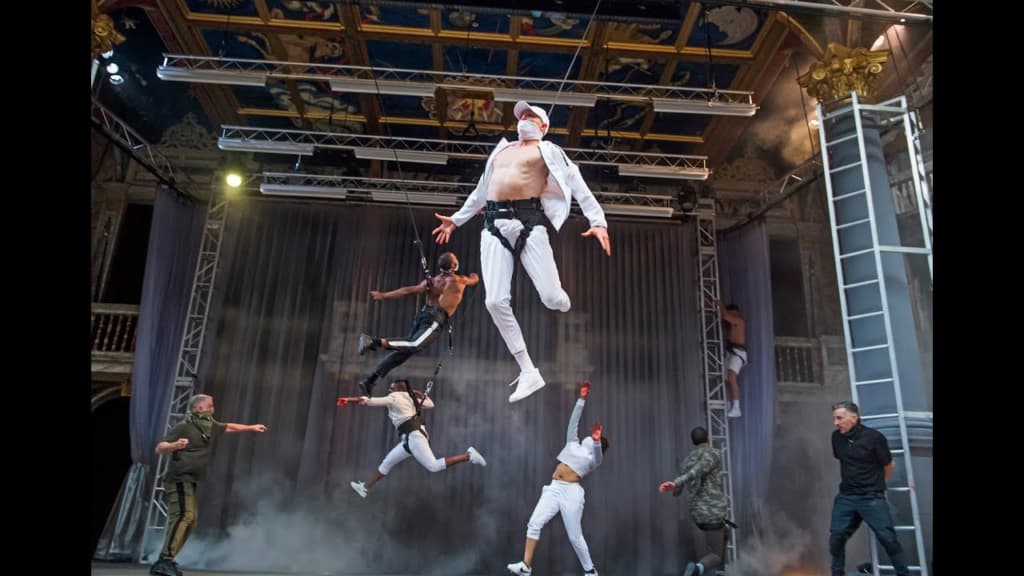
Cymbeline Reimagined: Triumph at Shakespeare’s Globe
Alfreds’s directorial technique bestows a visual cohesiveness upon Shakespeare’s ‘Cymbeline,’ a play once critiqued by Dr. Johnson for its seemingly disjointed composition. Alfreds adeptly marries the divergent themes of Britain and Rome, and the epochs of classical antiquity with the Renaissance. His approach facilitates near-instantaneous scene changes, exemplified by the succinct announcement of “Rome” following the striking of a gong, catapulting the audience to a new location in a mere moment.
Performance Dynamics at Shakespeare’s Globe
The execution of Shakespeare’s direction for celestial apparitions is approached with a minimalist flair. When “Jupiter descends,” the portrayal is distilled to the mere gesture of an actor reaching towards the heavens, a testament to the power of suggestion and the audience’s willingness to embrace theatrical abstraction.
Cast Highlight: The Duality of Rylance
The ensemble’s equilibrium is challenged by the dynamic presence of Mark Rylance, whose roles as Cloten, Posthumus, and the physician are imbued with such distinct energy, that they threaten to eclipse his peers. His interpretation of Cloten is a consummate depiction of vengeful foolishness, and his Posthumus embodies a frenetic transformation reminiscent of Leontes. His portrayal of the physician, with a mere aside to the audience, garners considerable acclaim.
Production High Points and Audience Interaction
John Ramm’s Iachimo and Jane Arnfield’s Imogen deliver performances that crystallize with clarity, the former rendering the invasive entry into Imogen’s chamber palpably convincing, the latter invoking her male disguise with a simple proclamation. The production’s ability to resonate with clarity despite the frenzied finale speaks volumes of the Globe’s potential to captivate with its storytelling prowess.
Concluding Remarks
Alfreds’s interpretation demonstrates that the Globe’s essence as a theatrical space can be fully realized by focusing on narrative over spectacle. The production’s resonance is occasionally overshadowed by an audience’s robust reaction to the physical comedy, which could be perceived as overzealous.
Performance Details
- Venue: Shakespeare’s Globe;
- Show Run: Until September 23;
- Box Office Contact: 020 7401 9919;
- Website with detailed information.
Comparative Table: Cymbeline at the Globe vs. Traditional Renditions
| Feature | Cymbeline at the Globe | Traditional Rendition |
|---|---|---|
| Directorial Approach | Minimalist, focused on visual unity | Often lavish with historical accuracy |
| Scenic Transitions | Swift and suggestive, using minimal props | Typically use detailed sets and longer transitions |
| Interpretation of Jupiter | Symbolic gesture | Often elaborate special effects |
| Actor Dynamics | Dominated by transformative performances | Usually a balanced ensemble effort |
| Audience Interaction | Encouraged, part of the Globe experience | More restrained, less interactive |
| Production Focus | Narrative clarity | Equally weighted on spectacle and story |
Key Highlights of Cymbeline at the Globe
- Innovative Staging: Alfred’s approach contrasts starkly with traditional productions, favoring simplicity and rapid scene changes;
- Actor Mark Rylance: Delivers a powerful, scene-stealing performance, playing multiple roles with a distinctive fervor;
- Minimalist Effects: The production makes use of simple, yet effective, theatrical techniques to convey grand themes;
- Audience Engagement: The Globe’s unique setting offers a lively, interactive experience, amplifying the humor and pathos of the play;
- Narrative Emphasis: Unlike typical renditions that strive for visual splendor, this production shines a light on the story’s progression and the characters’ journeys.
Video Guide
If you still have questions, we suggest you watch this video. Enjoy watching it!
Conclusion
The rendition of ‘Cymbeline’ at the Globe Theatre underscores the transformative power of minimalist theater, where the essence of narrative and actor-audience synergy triumphs over ornate production values. This production serves as a testament to the enduring nature of Shakespeare’s work, capable of innovation and resonance within the confines of a historically rooted stage. It invites both purists and modernists to a shared space of appreciation, challenging preconceptions and reinvigorating the timeless dialogue between the stage and its spectators.